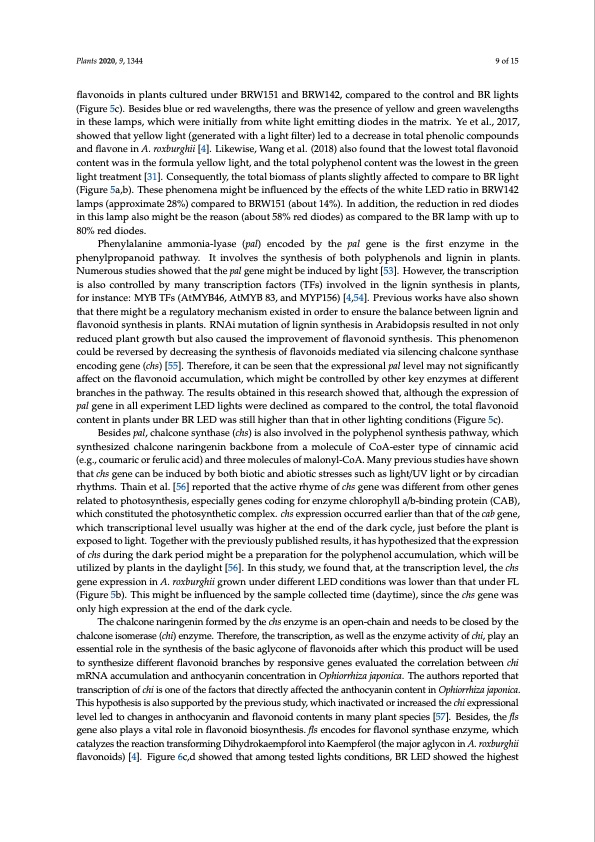
PDF Publication Title:
Text from PDF Page: 009
Plants 2020, 9, 1344 9 of 15 flavonoids in plants cultured under BRW151 and BRW142, compared to the control and BR lights (Figure 5c). Besides blue or red wavelengths, there was the presence of yellow and green wavelengths in these lamps, which were initially from white light emitting diodes in the matrix. Ye et al., 2017, showed that yellow light (generated with a light filter) led to a decrease in total phenolic compounds and flavone in A. roxburghii [4]. Likewise, Wang et al. (2018) also found that the lowest total flavonoid content was in the formula yellow light, and the total polyphenol content was the lowest in the green light treatment [31]. Consequently, the total biomass of plants slightly affected to compare to BR light (Figure 5a,b). These phenomena might be influenced by the effects of the white LED ratio in BRW142 lamps (approximate 28%) compared to BRW151 (about 14%). In addition, the reduction in red diodes in this lamp also might be the reason (about 58% red diodes) as compared to the BR lamp with up to 80% red diodes. Phenylalanine ammonia-lyase (pal) encoded by the pal gene is the first enzyme in the phenylpropanoid pathway. It involves the synthesis of both polyphenols and lignin in plants. Numerous studies showed that the pal gene might be induced by light [53]. However, the transcription is also controlled by many transcription factors (TFs) involved in the lignin synthesis in plants, for instance: MYB TFs (AtMYB46, AtMYB 83, and MYP156) [4,54]. Previous works have also shown that there might be a regulatory mechanism existed in order to ensure the balance between lignin and flavonoid synthesis in plants. RNAi mutation of lignin synthesis in Arabidopsis resulted in not only reduced plant growth but also caused the improvement of flavonoid synthesis. This phenomenon could be reversed by decreasing the synthesis of flavonoids mediated via silencing chalcone synthase encoding gene (chs) [55]. Therefore, it can be seen that the expressional pal level may not significantly affect on the flavonoid accumulation, which might be controlled by other key enzymes at different branches in the pathway. The results obtained in this research showed that, although the expression of pal gene in all experiment LED lights were declined as compared to the control, the total flavonoid content in plants under BR LED was still higher than that in other lighting conditions (Figure 5c). Besides pal, chalcone synthase (chs) is also involved in the polyphenol synthesis pathway, which synthesized chalcone naringenin backbone from a molecule of CoA-ester type of cinnamic acid (e.g., coumaric or ferulic acid) and three molecules of malonyl-CoA. Many previous studies have shown that chs gene can be induced by both biotic and abiotic stresses such as light/UV light or by circadian rhythms. Thain et al. [56] reported that the active rhyme of chs gene was different from other genes related to photosynthesis, especially genes coding for enzyme chlorophyll a/b-binding protein (CAB), which constituted the photosynthetic complex. chs expression occurred earlier than that of the cab gene, which transcriptional level usually was higher at the end of the dark cycle, just before the plant is exposed to light. Together with the previously published results, it has hypothesized that the expression of chs during the dark period might be a preparation for the polyphenol accumulation, which will be utilized by plants in the daylight [56]. In this study, we found that, at the transcription level, the chs gene expression in A. roxburghii grown under different LED conditions was lower than that under FL (Figure 5b). This might be influenced by the sample collected time (daytime), since the chs gene was only high expression at the end of the dark cycle. The chalcone naringenin formed by the chs enzyme is an open-chain and needs to be closed by the chalcone isomerase (chi) enzyme. Therefore, the transcription, as well as the enzyme activity of chi, play an essential role in the synthesis of the basic aglycone of flavonoids after which this product will be used to synthesize different flavonoid branches by responsive genes evaluated the correlation between chi mRNA accumulation and anthocyanin concentration in Ophiorrhiza japonica. The authors reported that transcription of chi is one of the factors that directly affected the anthocyanin content in Ophiorrhiza japonica. This hypothesis is also supported by the previous study, which inactivated or increased the chi expressional level led to changes in anthocyanin and flavonoid contents in many plant species [57]. Besides, the fls gene also plays a vital role in flavonoid biosynthesis. fls encodes for flavonol synthase enzyme, which catalyzes the reaction transforming Dihydrokaempforol into Kaempferol (the major aglycon in A. roxburghii flavonoids) [4]. Figure 6c,d showed that among tested lights conditions, BR LED showed the highestPDF Image | LED Lights Promote Growth and Flavonoid Accumulation of Anoectochilus roxburghii

PDF Search Title:
LED Lights Promote Growth and Flavonoid Accumulation of Anoectochilus roxburghiiOriginal File Name Searched:
plants-09-01344.pdfDIY PDF Search: Google It | Yahoo | Bing
Cruise Ship Reviews | Luxury Resort | Jet | Yacht | and Travel Tech More Info
Cruising Review Topics and Articles More Info
Software based on Filemaker for the travel industry More Info
The Burgenstock Resort: Reviews on CruisingReview website... More Info
Resort Reviews: World Class resorts... More Info
The Riffelalp Resort: Reviews on CruisingReview website... More Info
| CONTACT TEL: 608-238-6001 Email: greg@cruisingreview.com | RSS | AMP |